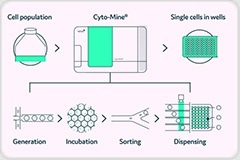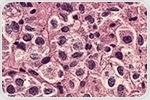| Cell Biology - Peak proteomics productivity for degenerative neurological disease research |
|
|
|
|
| |
|
| |
The latest cell & molecular biology news from News Medical |
|
|
|
 | | |
 Free Poster: Novel Bioassays in Picodroplets Free Poster: Novel Bioassays in Picodroplets
Using microfluidic devices with well-defined microchannel geometries and accurate flow control, uniform picolitre volume droplets (picodroplets) can be generated and used as miniaturized “test tubes” for high-throughput bioassays. Confining individual cells into picodroplets enables the implementation of a range of novel bioassays and applications in biotherapeutic discovery and development, cell therapy research, genome editing, and immuno-oncology.
| |
|
|
|
|
 | | |  Researchers investigating the association between white blood cell count and LDL hypercholesteremia. Researchers investigating the association between white blood cell count and LDL hypercholesteremia. | | | | |  Abdominal obesity increases the risk of severe COVID-19 and mortality due to heightened inflammatory responses, according to a study on Japanese patients and a murine COVID-19 model. Blocking inflammatory cytokines and preventing obesity may improve survival rates. Abdominal obesity increases the risk of severe COVID-19 and mortality due to heightened inflammatory responses, according to a study on Japanese patients and a murine COVID-19 model. Blocking inflammatory cytokines and preventing obesity may improve survival rates. | | | | |  Treatment with luspatercept improved red blood cell counts and erythroid responses compared to treatment with epoetin alfa in patients with myelodysplastic syndromes (MDS), allowing the majority to no longer require regular blood transfusions. Treatment with luspatercept improved red blood cell counts and erythroid responses compared to treatment with epoetin alfa in patients with myelodysplastic syndromes (MDS), allowing the majority to no longer require regular blood transfusions. | | | | |  A previously unknown function for the SWI/SNF chromatin remodeling complex has been revealed by researchers at St. Jude Children’s Research Hospital. A previously unknown function for the SWI/SNF chromatin remodeling complex has been revealed by researchers at St. Jude Children’s Research Hospital. | | | | |  Our cells are crisscrossed by a system of membrane tubes and pockets called the endoplasmic reticulum (ER). It is crucial for the production of biomolecules and is continuously built up and degraded. Our cells are crisscrossed by a system of membrane tubes and pockets called the endoplasmic reticulum (ER). It is crucial for the production of biomolecules and is continuously built up and degraded. | |
|
|
|
|
|
|